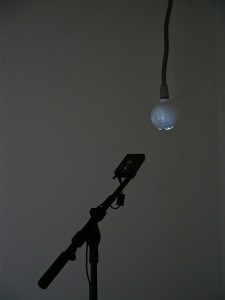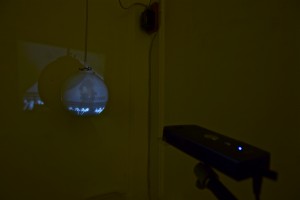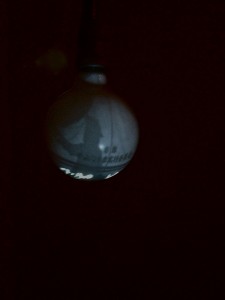Autumn Moon
Bright moon,
welcome to my hut –
such as it is
Kobayashi Issa, 1763 -1828
Some thoughts on the work; my ideas, intentions and approach.
This work is made from a video recording I made in Kyoto, Japan on the night of the festival of the Harvest Moon, Tsukimi, which is an annual Japanese tradition in which parties are held to view the harvest moon. The work plays a short loop of image and sound projected onto a randomly flashing light bulb, which echoes the action within the sequence.
The Haiku form and its relationship to the installation.
There are a number of traditional poetic forms that are associated with the night of the harvest moon, and this work draws on the Haiku. A traditional Japanese haiku always has a “season-word”, and this can be related to the idea of the Harvest or Autumn Moon.
A Haiku poem is always firmly based on an immediate experience and therefore written in the present tense. The poems do not cover a wide time-span, but happen in an instant, corresponding to “now”. As everything in haiku is always in the present tense, I wanted to evoke a sense of the present or the “here and now” in work. I want to create a sense that what is being viewed is not something that has happened in the past, but of something that is unfolding right now in front of the eyes of the viewer- at the moment it is appearing. This relates to my experience of making gallery installation work. In my installations I am interested in producing an experience in which the viewer can engage with the work in as direct a way as possible, decoding the meanings and ideas by a direct interaction with the various elements of the work to construct an individual “dialogue” with the work in the gallery/exhibition space.
The Two-Image Haiku
Some haiku are a single image and very rarely they have three images; but the majority are composed of two images, separated by a kireji or “cutting word” in Japanese haiku. In the English translation this is usually represented by a punctuation mark (an exclamation mark for emphasis, or a dash). Sometimes the effect of the kireji is expressed by “Alas!” or “Ah!” This relates to my use of the flashing bulb to mark the cut or exclamation, momentarily obliterating the image (and the illusion) and evoking the “here and now” of the present moment.
The two images of which the poem is constructed “resonate” with each other to create a mood, atmosphere or impression. The link between the two images is not specified and the reader is left to make the link, and thus to “step inside” the haiku, sharing it, in some sense, with the author. This attitude is important to my approach and echoes my interest in the notion of the viewer’s dialogue or engagement with the video work. There are also traditional moods and flavours to haiku that I have sought to emulate. In haiku the poem may be a description of a natural scene, but with a strong associated feeling and this approach is aligned to an interest in creating a level of individual personal interaction.
Haiku often have images that connect to universal oppositions, and this is very much an aspiration of the work, and an approach which I believe is very suited both to the subject matter of the installation (which is both a celebration of a visual phenomenon and a representation of a cultural manifestation) and to the audio-visual medium. Haiku poems often describe opposing forces that can be visually depicted, for example something in movement and something still; something massive and something delicate; something natural and something man made; rising things and falling things; a living thing and an inanimate one; warmth and chill; light and dark; something clear and something hazy. Haiku poetry may also bring together more subtle combinations that are beautiful in their contrast, but also equally possible to be presented or expressed in audio-visual terms: a sound and a touch; an emotion and an object; loneliness in company.


